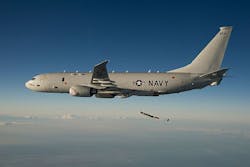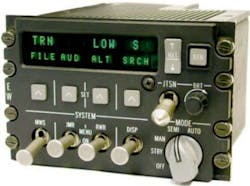Northrop Grumman to provide avionics cockpit control system for P-8A aircraft survivability
Officials of the Naval Air Warfare Center Aircraft Division in Lakehurst, N.J., announced a $14.3 million contract late last month to the Northrop Grumman Mission Systems segment in Rolling Meadows, Ill., for 38 Terma ALQ-213 electronic warfare management systems for the P-8A aircraft.
Terma’s ALQ-213(V) electronic warfare management unit offers a non-ITAR controller for a military aircraft survivability equipment (ASE) suite, which provides automatic threat reaction and decision support algorithms and on-board training for P-8A aircraft crews.
This contract comprises 27 ALQ-213 tactical threat displays for the U.S. Navy; three for the United Kingdom; eight for Australia, as well as 29 OMNI blade antennas for U.S. Navy; two for the United Kingdom; and eight for Australia.
The contract also involves component and system level software and hardware integration and testing prior to system delivery. Northrop Grumman and Terma agreed in 2007 to cooperate on airborne electronic warfare products and projects. Terma North America is the U.S. holding company for the North American activities of Terma A/S in Lystrup, Denmark.
The Terma ALQ-213(V) has an expansion slot for drop-in of one special purpose circuit cards. The expansion slot provides a fast PCI express interface to the dual-core CPU and can be supported by a dedicated external connector, with minimal impact to the unit design.
The electronic warfare management unit typically integrates several aircraft survivability equipment sensors and effectors typically via one or more MIL-STD-1553B data buses and discrete and serial interfaces.
The electronic warfare management unit can integrate cockpit multi-function display and control units or provide graphical human interaction via terma’s advanced threat display.
The electronic warfare management unit can integrate available sources for time, position, and attitude data to provide low-latency data in any required format to aircraft survivability equipment systems and functions.
On this contract Northrop Grumman will do the work in Rolling Meadows, Ill.; Seattle; Jacksonville Naval Air Station, Fla.; Whidbey Island Naval Air Station, Wash.; Lossimouth, Scotland; and Edinburgh, Australia, and should be finished by February 2020.
For more information contact Northrop Grumman Mission Systems online at www.northropgrumman.com, Terma North America at www.terma.com, or the Naval Air Warfare Center Aircraft Division-Lakehurst at www.navair.navy.mil.
Learn more: search the Aerospace & Defense Buyer's Guide for companies, new products, press releases, and videos


